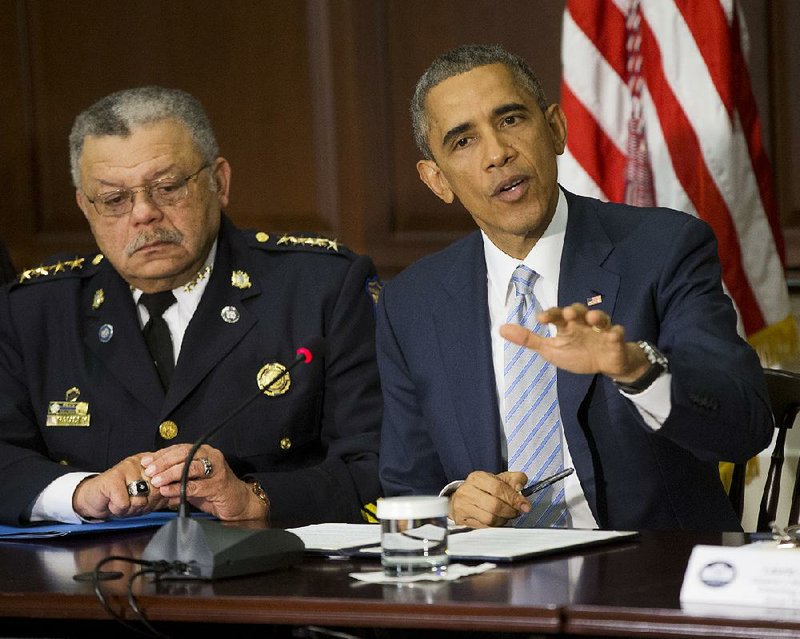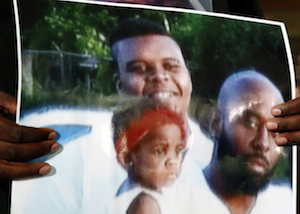WASHINGTON -- President Barack Obama on Monday announced he would tighten standards on the provision and use of military-style equipment by local police departments, but he stopped short of curtailing the transfer of such hardware or weapons to the local authorities.
Obama announced the plan at a Cabinet meeting that was called to deal with lingering tensions from fiery clashes between the police and protesters in Ferguson, Mo., that broke out after a grand jury declined to indict a police officer for fatally shooting an unarmed black 18-year-old.
"We can build confidence and we can build trust," Obama told representatives from civil-rights groups, law enforcement, religious institutions, local and national government, and others at a later gathering. "But it's not going to happen overnight."
The president's directive comes after the release of a new White House review of the government's decade-old strategy of outfitting local police forces with military equipment. The review found the so-called surplus programs of the Department of Defense and other federal agencies to be a mishmash of rules and practices, with no clear sign that all police are properly trained and certified to use the military-grade equipment they receive.
With the report newly in hand and no legislation on the horizon, Obama has focused on standardizing regulations and instructing his staff to come up with a list of military gear that has a legitimate civilian law enforcement purpose and thus can be sent to local police forces around the country, said senior administration officials.
The new rules will require that local nonpolice officials review and authorize the acquisition of small arms and all other "controlled" equipment by their communities.
He also will seek to improve training and require "after action" reports for accidents involving federally funded equipment.
The rules will come within the next four months in the form of an executive order governing the Pentagon and all other federal agencies that run surplus programs that distribute military-style equipment to police around the country.
"What he's asking his agencies to do is add a very specific layer of accountability," said one senior administration official familiar with the program. "These layers of accountability aren't currently present in the program."
Additionally, Obama is asking Congress for a three-year, $263 million community-policing package that includes $74 million that, along with matching funds from local governments, would supply up to 50,000 body-worn cameras to record officers on the job, according to an administration fact sheet.
The White House report found "a lack of consistency in how federal programs are structured, implemented and audited."
Five federal departments or agencies supply hardware such as small arms and night-vision goggles to local agencies, according to the White House, which said that only 4 percent of the surplus equipment that comes from the Pentagon is actually combat-ready hardware. Most of it is office equipment.
The executive order being drafted directs government agencies to work with civil-rights groups to ensure all equipment has a legitimate civilian law enforcement purpose and that training programs are in place.
That won't mean such programs would be curtailed, because they are useful, White House press secretary Josh Earnest said Monday in a briefing with reporters. He cited the military equipment used by local authorities after the Boston Marathon bombing.
"We've found that in many cases, these programs actually serve a very useful purpose," Earnest said. "What is needed, however, is much greater consistency in oversight."
The militarization of the police is part of a broader counterterrorism strategy of fortifying U.S. cities, which took root after the terrorist attacks of Sept. 11, 2001.
But images of police in Ferguson in military-style uniforms and wielding automatic weapons atop armored vehicles helped stoke anger in the city and prompted some calls in Congress to examine the practice.
The White House's moves came on a carefully orchestrated day of meetings to telegraph a robust White House response to the unrest in Ferguson.
At a separate meeting with young civil-rights leaders, including two from Ferguson, the president said he understood their frustration with a legal system that they believe is stacked against them. But he implored them not to lose hope.
"When I hear the young people around this table talk about their experiences, it violates my belief in what America can be," Obama said.
Still, he has so far resisted going to Ferguson himself. White House officials said that while a visit was being discussed, they were concerned about siphoning police resources needed to prevent a fresh outbreak of rioting in the streets.
Meanwhile, Attorney General Eric Holder traveled to Atlanta on Monday to meet with law enforcement and community leaders for the first in a series of regional meetings around the country. Speaking at Ebenezer Baptist Church in Atlanta, he said he will soon unveil long-planned Justice Department guidance aimed at ending racial profiling.
"This will institute rigorous new standards -- and robust safeguards -- to help end racial profiling once and for all," Holder said. "This new guidance will codify our commitment to the very highest standards of fair and effective policing."
Holder also told the crowd that the meetings he's convening across the country are just the beginning and that he wants to start a frank dialogue and then translate that into concrete action and results.
The president also announced the formation of a task force to improve local policing. Its chairmen will be Charles Ramsey, the commissioner of the Philadelphia police, and Laurie Robinson, a former assistant attorney general and professor at George Mason University in Fairfax, Va.
The task force will examine "how to promote effective crime reduction while building public trust," according to a White House statement, and make recommendations within 90 days.
Pushing back on concerns that the task force would be all talk and no action, Obama said this situation was different because he was personally invested in ensuring results. He said young people had relayed stories about being marginalized in society and said those stories violate "my idea of who we are as a nation.
"In the two years I have remaining as president," Obama said, "I'm going to make sure we follow through."
The Justice Department also is conducting two inquiries in Ferguson. The first is reviewing whether police officer Darren Wilson violated federal civil-rights laws when he shot and killed Michael Brown on Aug. 9. The other is a broader look at whether Ferguson police have a pattern of violating citizens' rights. Neither investigation is nearing completion.
Raised hands
While tense calm in Ferguson has replaced the days of violent demonstrations, a more restrained form of protest has taken hold across the country.
Recently, five St. Louis Rams players entered the football field with their hands raised. A day later, people walked out of work or school showing the same gesture of solidarity with Missouri protesters.
The pose has come to symbolize a movement, even though witnesses offered conflicting accounts of whether Brown had his hands up in surrender when he was killed by Wilson.
The power of the symbol was evident again Monday. Protesters across the country walked off the job or away from class in support of the Ferguson protesters. Walkouts took place in New York, Chicago, San Francisco and elsewhere.
At the University of Missouri-St. Louis, not far from Ferguson, sophomore Amber Whitaker was among about 30 students who chanted "Hands up. Don't shoot."
Whitaker, who is white, said the symbolism is what matters, not whether Brown literally had his hands in the air.
"There are black men and women who are shot with their hands up," Whitaker said. "There are black men and women who are shot unarmed. It may not apply exactly to Mike Brown, but it still happens."
The exact circumstances regarding Brown's death are in dispute. Wilson told the grand jury that he shot Brown in self-defense. But several witnesses said Brown had his hands up in surrender. Within hours of the shooting, "Hands up, don't shoot " became the rallying cry for protesters.
Witness accounts contained in thousands of pages of grand jury documents showed many variations about whether Brown's hands were actually raised.
Some people were offended by the hands-up gesture.
The St. Louis Police Officers Association said the display by Rams players Tavon Austin, Kenny Britt, Stedman Bailey, Jared Cook and Chris Givens was "tasteless, offensive and inflammatory."
The group, joined by the St. Louis County Police Association, met with Rams leaders Monday. Rams coach Jeff Fisher said during a news conference that neither the team nor the NFL will discipline the five players for the gesture.
In Springfield, Mo., Rodney Shetler, watched the players' action from his home. He said the move was "in pretty poor taste" and was divisive and disrespectful to law enforcement.
"It's a gesture proven by the grand jury not to be appropriate or accurate," said Shetler, the 44-year-old owner of a copying and printing business.
A similar episode unfolded more than four decades ago at the 1968 Olympics in Mexico City.
John Carlos, the American 200-meter bronze medalist, set off a political firestorm on the medal stand when he and teammate Tommie Smith gave the black power salute. Carlos stood by the Rams players.
"If they choose to come out and raise their hands in support of whatever their emotions are, they have the right to do that," he said. "I don't think the whole story has been told about the Michael Brown tragedy, and the pros and cons on both sides. They can just go by their emotions. I don't think anyone got injured or shot by expressing emotions."
Elsewhere Monday, the Ferguson Commission appointed by Missouri Gov. Jay Nixon met for the first time. The 16-person panel will study the underlying social and economic conditions -- from failing schools to high unemployment -- that have gained attention since Brown's death.
About 80 residents attended the group's first session, a five-hour meeting devoted primarily to organizational issues.
Information for this article was contributed by Mark Landler and Matt Apuzzo of The New York Times; by Roger Runningen and Mike Dorning of Bloomberg News; by Nedra Pickler, Jim Salter, Jim Suhr, Alan Scher Zagier, David A. Lieb, Eddie Pells, Kate Brumback, Eric Tucker and Joe Harris of The Associated Press; and by Christi Parsons of the Tribune News Service.
A Section on 12/02/2014
28209923

